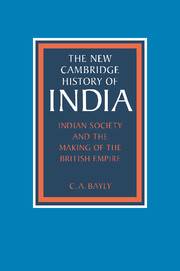Book contents
- Frontmatter
- Introduction
- 1 India in the eighteenth century: the formation of states and social groups
- 2 Indian capital and the emergence of colonial society
- 3 The crisis of the Indian state, 1780–1820
- 4 The consolidation and failure of the East India Company's state, 1818–57
- 5 Peasant and Brahmin: consolidating ‘traditional’ society
- 6 Rebellion and reconstruction
- Conclusion: the first age of colonialism in India
- Glossary of indian terms
- Bibliographical essay
- Index
- THE NEW CAMBRIDGE HISTORY OF INDIA
- Plate Section"
Conclusion: the first age of colonialism in India
Published online by Cambridge University Press: 28 March 2008
- Frontmatter
- Introduction
- 1 India in the eighteenth century: the formation of states and social groups
- 2 Indian capital and the emergence of colonial society
- 3 The crisis of the Indian state, 1780–1820
- 4 The consolidation and failure of the East India Company's state, 1818–57
- 5 Peasant and Brahmin: consolidating ‘traditional’ society
- 6 Rebellion and reconstruction
- Conclusion: the first age of colonialism in India
- Glossary of indian terms
- Bibliographical essay
- Index
- THE NEW CAMBRIDGE HISTORY OF INDIA
- Plate Section"
Summary
By 1860 India was locked into a pattern of imperial subordination which was to be essentially maintained, despite formal constitutional changes, until 1935. The Indian Army had rid itself of the troublesome Hindi-speaking villagers of the Gangetic plains. The post-Mutiny army, furnished with a steady supply of Punjabi recruits, now carefully segregated on grounds of caste and religion, was forged into a reliable mercenary force for internal security or protection of the North-West Frontier against the supposed Russian threat. Indian troops were also dispatched with more confidence to East and South Africa, South-East Asia and ultimately, in 1914, to Europe itself. Detachments of troops from quiescent native states added to the paper strength of this large land army. Most pleasing of all to the new India Office in London and to the British Treasury, Indian taxation, which had been reorganised after 1857, continued to bear the cost of this expensively re-equipped force.
A more satisfactory imperial economic relationship – from the British point of view – had also emerged after the 1840s, though this was somewhat obscured by the bloody drama of 1857. Exports of British-manufactured textiles picked up sharply, despite a lull in the 1860s. Indian merchants created an excellent inland retailing system for Lancashire goods in eastern and southern India and they were now linked to the sea-ports by railway lines. It was calculated that one-third of the demand for moderate and finer cloth in Bengal and Bihar was met by British imports by 1860. Raw material exports to the developed world had also achieved a more stable trend.
- Type
- Chapter
- Information
- Indian Society and the Making of the British Empire , pp. 200 - 206Publisher: Cambridge University PressPrint publication year: 1988



